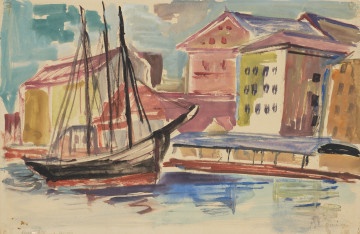
Szczecin Harbour
około 1930
National Museum in Szczecin
Part of the collection: European classics of modernity
Julo Levin started his studies at the School of Arts and Crafts in Szczecin and subsequently, between 1919 and 1920, he attended the Folkwang University of the Arts in Essen, while between 1921 and 1923 he was a student at the Munich Academy. Over the next years, he continued his education at the Düsseldorf Academy, receiving a diploma in 1926. His works are characterised by the ability to eliminate details and the striving for the simplification of forms, leading to the harmony of composition and clarity of forms. The works of the Szczecin artist, forming a part of the German Expressionism, were significantly influenced by Johan Thorn Prikker and Heinrich Nauen. Levin belonged to avant-garde art groups Rheinische Sezession (Rhineland Secession), Das Junge Rheinland (Young Rhineland), Assoziation Revolutionärer Bildender Künstler ASSO (Association of Revolutionary German Painters) and Das neue Pommern (New Pomerania). In 1931, he made a study trip to the south of France; he frequently visited Szczecin and Pomerania. In 1933, the works of Levin were determined as the manifestation of the “degenerate art.” The artist was banned from publicly presenting his works and being professionally active. During the time of national socialism, he worked as a street cleaner, cemetery worker and was also employed in several Jewish schools in Düsseldorf, and later in Berlin where he taught drawing. On 17 May 1943 he was sent to Auschwitz. A small watercolour entitled “Church with a Green Tower” is a recollection of Levin's stay in Szczecin at the beginning of the 1930s. The painting shows a fragment of the harbour quay by the Oder with a view towards the Łasztownia (Lastadia) River and the neo-Gothic church of St. Gertrude located there (nowadays the Evangelical and Augsburg Church of the Holy Trinity), built by the Szczecin municipal architect, Wilhelm Meyer-Schwartau. Bold brush strokes, expressive painter’s gesture, courageous juxtaposition of saturated colours and geometric shapes determine the power of expression of the work.
Dariusz Kacprzak
Author / creator
Dimensions
cały obiekt: height: 28,5 cm, width: 39 cm
Object type
painting
Creation time / dating
Creation / finding place
Identification number
Location / status

około 1930
National Museum in Szczecin

1920 — 1935
National Museum in Szczecin

około 1930
National Museum in Szczecin
DISCOVER this TOPIC
National Museum in Szczecin
DISCOVER this PATH
Educational path